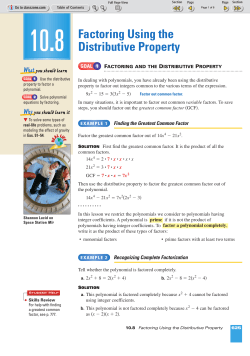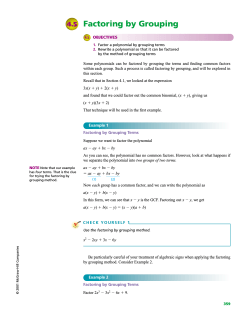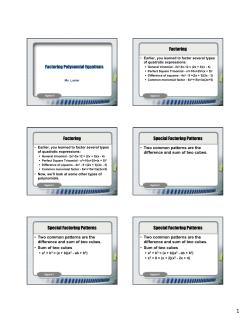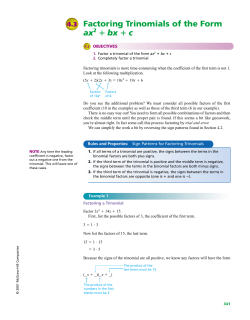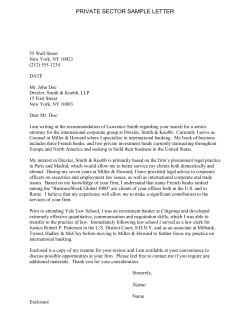
J ournal
Journal AMERICAN BANKRUPTCY INSTITUTE The Essential Resource for Today’s Busy Insolvency Professional American Factoring Law Written by: David B. Tatge, David Flaxman and Jeremy B. Tatge (BNA Books 2009; Supplement 2011) Reviewed by: Mary H. Rose Buchalter Nemer PC; Los Angeles mrose@buchalter.com F actoring is big business in America. The Commercial Finance Association (CFA) reported total factoring volume of $74.3 billion in 2010. This figure is particularly impressive when compared to the statistics for asset-based lending. According to CFA, the total volume of asset-based loans outstanding at year-end 2010 was $66.1 billion, with total credit line commitments of $180.7 billion.1 Notwithstanding this highly respectable volume of factoring, the mention of factoring among sophisticated financial and bankruptcy lawyers tends to evoke indulgent Mary H. Rose smiles as if one had quaintly suggested a horse-and-buggy ride. Unless, of course, the sophisticated financial or bankruptcy lawyer is faced with an actual factoring question. The ensuing confused reaction is usually followed by the rapid assumption that factoring must be just a variant of a secured loan. After all, we all know that there are only two types of lending: secured and unsecured. Well, that is true, but financing encompasses more than lending, and while factoring is a form of financing, it is not a form of lending. Indeed, as a point of etiquette, one should never refer to a factor as a lender. They like and deserve to be called by the honorable title of “Factor.” 1 CFA, “Annual Asset-Base Lending and Factoring Survey Highlights 2010.” The CFA survey was based on “data reported by almost 40 of the largest asset-based lenders and factors (estimated to comprise more than 90 percent of the activity in their respective industries).” About the Reviewer Mary Rose is a shareholder of Buchalter Nemer PC in Los Angeles. Her practice includes factoring of health care receivables both in and outside of bankruptcy. Before the main volume of American Factoring Law was published in December 2009, the literature on American factoring consisted of a few articles, some relatively brief sections in commercial finance treatises and marketing brochures issued by factors themselves. There was no comprehensive treatise on factoring law that could explain why the factoring agreement you were reading was cases (with polite criticism of incorrectly decided cases), references to online court dockets and supplemental materials, descriptions of industry-specific factoring facilities, a glossary of factoring terms, and materials on proper accounting and tax treatment. For the factoring aficionado, there is even an in-depth chapter on the history of American factoring, which is worth reading for the perspective and insight it gives to modern factoring concepts. The chapters on “true sales” and debtor in possession (DIP) factoring are likely to be of most interest to insolvency practitioners. True Sales The crucial difference between factoring and accounts-receivable financing is that the factor purchases Suggested Reading structured the way it was, how it differed from other factoring agreements and whether the courts were likely to enforce the provisions of your factoring agreement and the operational procedures of your factor in the way you hoped they would. American Factoring Law has definitively changed all of that. It is a comprehensive, well organized, exhaustively researched and, above all, clear statement and explanation of modern factoring law. Whether you are a neophyte in the world of factoring or a seasoned practitioner, this book is a must-have for your law library, and possibly for your own office bookcase. This book has everything you ever wanted to know about factoring but had no one to ask. It includes not only descriptive explanations and commentary, but sample provisions from a variety of types of factoring agreements, discussions of significant factoring and owns the accounts. The accounts receivable lender lends against accounts and is granted a security interest in the accounts, but the accounts continue to be owned by the debtor. The distinction is critical in a bankruptcy case because a factor that has purchased pre-petition accounts on a “true-sale” basis owns the accounts and can continue to collect on the accounts without bankruptcy court approval. A secured lender must seek relief from the automatic stay in order to realize on its collateral and apply the proceeds to its debt. As explained in American Factoring Law, one of the reasons for confusion with respect to this simple concept is that Article 9 of the Uniform Commercial Code (UCC) covers both outright sales of accounts where title is transferred to the factor, and loans against accounts that continue to be owned by the debtor and are merely pledged to the lender as security for the loan. Moreover, many terms such as 44 Canal Center Plaza, Suite 400 • Alexandria, VA 22314 • (703) 739-0800 • Fax (703) 739-1060 • www.abiworld.org “security interest,” “collateral,” “debtor” and “secured party” are defined in the UCC and cover both types of transactions.2 In fact, a factor under the UCC receives a “security interest” as a buyer and owner of accounts and must “perfect” the security interest by filing a UCC financing statement. A factor that fails to perfect its ownership interest by filing a UCC financing statement will lose to a perfected lien creditor, as well as to the interest of a trustee in bankruptcy under the strong-arm provisions of § 544 of the Bankruptcy Code.3 Another source of confusion in the true-sale analysis arises from the fact that factoring may be done either on a “nonrecourse” or “recourse” basis. Both nonrecourse and recourse factoring, and numerous subcategories and hybrids, are lucidly described in American Factoring Law, together with a true-sale analysis of each category.4 In essence, recourse is the factor’s right to charge its client and receive payment for losses experienced by the factor on accounts purchased from the client. Nonrecourse factoring means that the factor has no “credit recourse” and cannot charge back losses on accounts that are not collected due solely to the bankruptcy, insolvency or financial inability to pay of the account obligor. The assumption of credit risk by the factor is a key element that distinguishes factoring from secured lending. A factor that has assumed the credit risk on an account that is uncollected due to the bankruptcy, insolvency or financial inability to pay off the account obligor cannot recover the purchase price that it paid to its client and must pay the client any balance of the purchase price that may still be owed on the account. In contrast, a secured lender has recourse against its borrower and other pledged assets of its borrower for the amount advanced against the uncollected account, plus interest. Factoring transactions in which the factor has no credit recourse with respect to purchased accounts are easily categorized as true sales. However, factoring agreements in which the factor does not have credit recourse neverthe2 See, e.g., UCC § 1-201(b)(35) (defining “security interest” to include “any interest...of a buyer of accounts...in a transaction that is subject to Article 9”); UCC § 9-102(a)(12) (defining “collateral” as “[t]he property subject to a security interest... The term includes...accounts...that have been sold.”); UCC § 9-102(a)(28) (defining “debtor” to include “a seller of accounts”); UCC § 9-102(a)(72)(D) (defining “secured party” to include “a person to which accounts...have been sold”); UCC § 9-109(a) (3) (stating that Article 9 applies to “[a] sale of accounts”). 3 American Factoring Law, Chapter I.V.F. 4 American Factoring Law, Chapter 4, describes factoring on a nonrecourse, partial nonrecourse, partial (or modified) recourse, split-risk or full-recourse basis. less permit the factor to retain “quality recourse” with respect to purchased accounts, and such transactions are still considered nonrecourse and respected as true sales. Quality recourse means that the factor retains the right to charge its client for any advance or other payment made on an account (1) that is the subject of a dispute by the account obligor, (2) with respect to which the account obligor makes offset, counterclaims or recoupment claims, or (3) that otherwise breaches representations, warranties or covenants made by the client to the factor. Typically, the factoring client can satisfy the recourse obligation by repurchasing the account for cash, substituting a new account on which the factor makes no cash payments or charging the reserve held by the factor. The concept is similar to the right of a buyer of goods to rescind a sale of nonconforming goods or goods as to which the seller does not have clear title.5 The sale is still a true sale. A full-recourse factor assumes that neither quality nor credit risk and can charge back any account that is not collected after a specified period of time. Except in Texas and Louisiana, where nonuniform provisions of the UCC state that the parties’ contractual characterization of the transaction as a sale is controlling, such transactions are generally treated as secured loans by the courts, regardless of the labels used by the parties.6 DIP Factoring Many financially robust companies factor their receivables. By its nature, factoring is especially well-suited to businesses that are in relatively weak or even poor financial condition but generate strong receivables because the factor, as a purchaser of receivables, is paid directly by the account obligors. The factor is primarily concerned with the collectibility of the receivables, not the creditworthiness of its client, and for this reason, factoring agreements, unlike loan agreements, typically do not contain extensive financial covenants. The conditions conducive to factoring tend to be prevalent in particular industries. For example, factoring 5 See, e.g., UCC § 2-312(1)(b) (“[T]here is in a contract for sale a warranty by the seller that...[t]he goods shall be delivered free from any security interest or other lien or encumbrance of which the buyer at the time of contracting has no knowledge.”); UCC § 2-601 (“[U]nless otherwise agreed...if the goods or the tender of delivery fail in any respect to conform to the contract, the buyer may (a) [r]eject the whole; or (b) [a]ccept the whole; or (c) [a]ccept any commercial unit or units and reject the rest.”). 6 See Tex. Bus. & Com. Code Ann. § 9.109(e); La. Rev. Stat. Ann. § 10:9-109(e). is widespread in the apparel industry, both for historical reasons and because even small and new apparel manufacturers can have sterling receivables from retailers. Trucking companies, agricultural producers, government contractors, hospitals and many others may similarly have strong receivables but little financial strength. Regardless of industry, factoring can be an attractive option for any financially troubled company that has good receivables. If the company properly uses its factoring facility by selling receivables only when it needs cash, the cost of a factoring facility can even be competitive with the cost of an asset-based loan. In view of the reluctance of many lenders to become involved in bankruptcy cases, even with all of the protections afforded to DIP lenders under the Bankruptcy Code, factoring can also be an ideal choice for DIP financing. As discussed in American Factoring Law, DIP factoring requires approval by the bankruptcy court as a sale of property out of the ordinary course of business under § 363(b) of the Code, and as a sale free and clear of liens, claims and encumbrances under § 363(f). Most factors also require approval of the factoring agreement as the incurring of secured indebtedness under § 364. The need for secured indebtedness arises because the factor typically demands a security interest in all accounts (whether or not purchased), as well as other assets, to secure chargebacks for ineligible accounts, overadvances (advances by the factor in excess of the purchase price for accounts) and the fees and expenses of the factor’s legal counsel. As a condition to providing the factoring facility, many factors also require that they be granted superpriority administrative expense treatment under § 364(c)(1).7 When a factoring facility is approved under both §§ 363 and 364, a good-faith DIP factor will receive protection from reversal or modification on appeal of the authorizing order under both §§ 363(m) and 364(e). Other Useful Information American Factoring Law covers a wealth of other useful topics, including rights of a factor upon default, claims of factors against clients and clients against factors, claims of factors against account obligors, claims between fac7 American Factoring Law, Chapter 12.II.F. 8 26 U.S.C. § 6321. 44 Canal Center Plaza, Suite 400 • Alexandria, VA 22314 • (703) 739-0800 • Fax (703) 739-1060 • www.abiworld.org tors and lenders to the same client, types of guaranties specific to factoring transactions, and the extent and timing of the priority of federal tax liens under § 6321 of the Internal Revenue Code. 8 There are even very practical sections on the legal and business issues to be addressed when a factor takes out an existing factor or lender, or a lender takes out an existing factor. One of the most useful features of American Factoring Law is that it is not only an informative reference book, but a solid factoring treatise that can be cited and quoted. The first supplement was published in April 2011, and it includes updates of material in the main volume as well as supplemental materials. The reputation of this treatise will continue to grow. The authors have performed a tremendous service both for the factoring world and for those who may one day enter upon it. n Reprinted with permission from the ABI Journal, Vol. XXX, No. 8, October 2011. The American Bankruptcy Institute is a multi-disciplinary, nonpartisan organization devoted to bankruptcy issues. ABI has more than 13,000 members, representing all facets of the insolvency field. For more information, visit ABI World at www. abiworld.org. 44 Canal Center Plaza, Suite 400 • Alexandria, VA 22314 • (703) 739-0800 • Fax (703) 739-1060 • www.abiworld.org
© Copyright 2025

